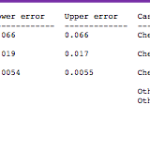
Project Gallery 2023
Secondary students from across Europe became exoplanet detectives with ESA and used Cheops satellite data to uncover the mysteries of two exoplanet targets: KELT-3b and TOI-560c.
Explore the projects below.
Maria
Best Project Prize Winner
Indus Space Mississauga – Ontario Canada 16 years old 1 / 1
KELT-3b
KELT-3b project description:
KELT-3b is an exoplanet that orbits the star KELT-3, which is located approximately 700 light-years away from Earth in the constellation Hercules. It was first detected in 2012 using the Kilodegree Extremely Little Telescope (KELT) survey. KELT-3b is a puffy and gaseous giant planet that is similar in size to Jupiter but with a mass about twice that of Jupiter. It has a very short orbital period of only 2.7 days, meaning it orbits very close to its host star. This proximity to the star has caused KELT-3b to have a very high surface temperature, estimated to be around 1543+37 -39 °C.
KELT-3b is an interesting target for astronomers who are studying exoplanets and their properties, and further observations and studies will likely provide more insights into their characteristics and formation.
TOI-560c
TOI-560c project description:
This exoplanet has captured the attention of astronomers due to its unique characteristics. We use many methods to discover facts about the exoplanet
such as direct image, transit photometry, and Radial velocity method. However, the most commonly used method is Transit photometry from the CHEOPS satellite . It is commonly known as the light curve method. A powerful technique used to measure and study exoplanets. To utilize the light curve method effectively, we have to:
● Observe a star that is suspected to have an exoplanet in its orbit.
● Establish a baseline measurement of the star’s normal brightness by recording its light intensity over a period of time.
● Watch for any periodic dips in the star’s brightness, which indicate the presence of an exoplanet passing in front of the star. These dips are
caused by the planet blocking a portion of the star’s light as it transits across.
● Measure various parameters of the transit, including the duration and depth of the dip. The duration provides information about the planet’s
orbital period, while the depth reveals the size of the planet.
● Analyze the collected data by plotting a graph, known as a light curve, which displays the star’s brightness over time. The light curve exhibits a
characteristic U-shaped dip during each transit event and extracts valuable information about the exoplanet from the light curve such as the
planet’s radius, orbital period, and even its distance from its host star.
TOI-560c Results and Analysis
Facts about TIO560c
● Radius of the planet: 2.392 Earth Radii
● Orbital period: 18.87 day
● Distance to host start: Orbital distance of 0.12 AU ( 18445417.5 km)
● Density : 0.2938 g/Cm^3
● Composition: TIO560 is a gas planet
● TOI-560c is an exoplanet located in the TOI-560 system, approximately 103.1 light-years away from the solar system.
● TOI-560c belongs to the class of gas exoplanets. Its star is 0.7 times more massive and 0.7 times bigger compared with our Sun. The surface temperature is 4511 with its spectral types of K4V.
● Its proximity to its host star results in a relatively short orbital period. TOI-560 c orbits around the star TOI-560 every 18.87 days with its orbital distance of 0.12AU ( 18445417.5 km)
● TOI-560c also experiences extreme temperatures due to its proximity to its star, which poses challenges to the existence of liquid water and life as we know it.
To obtain facts about an exoplanet from its light curve, we analyze changes in brightness over time. Periodic drops in brightness indicate transits when the exoplanet passes in front of its host star. The depth of transits reveals the exoplanet’s size relative to the star, while transit duration helps estimate its orbital period. Transit shape may indicate exomoons or additional planets. By examining these parameters in the light curve, and using certain measuring formulas, we can gather crucial information such as exoplanet size, orbital period, presence of exomoons or multiple planets, and study the system’s dynamics.
TOI-560c Conclusions
TOI-560c was identified in the Transiting Exoplanet Survey Satellite (TESS) mission data. It is a hot Neptune-like exoplanet that orbits a star named TOI-560. Comparing it to planets in our solar system, there are some general similarities and differences:
● Size and Composition: TOI-560c is a hot Neptune, meaning it is a gas giant, around the same size as Neptune but much closer to its star. In contrast, our solar system does not have a planet with a similar composition or size in such a close orbit.
● Orbital Characteristics: The exoplanet orbits its host star within a relatively short period, completing an orbit within a few days. The planets in our solar system have much longer orbital periods in comparison.
● Stellar Type: TOI-560, the host star of TOI-560c, is a sub-giant star, much larger than our Sun. The planets in our solar system orbit a G-type main-sequence star like the Sun.
Supporting files:



